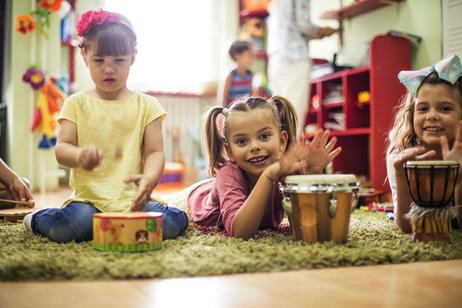Your baby is not even a year old, but already you're thinking about preschool. Should you send her to preschool or wait until kindergarten? Will she be OK in your local public school, or would the private preschool your friends and family keep mentioning be a better option? I've been there. Done that. Both of my daughters attended private preschools, mainly because back in the 70s, there was no public preschool option, at least that I can remember. Furthermore, I was blessed with a supportive mother-in-law who paid for her granddaughters' preschool. So, with that in mind, here are my suggestions to help you choose preschools that suit your needs and requirements best.
Which Early Education Approach?
Choosing the right early childhood education approach for your child is a significant decision that can shape her developmental journey. With various fine educational philosophies available, parents often face a confusing array of options. This article aims to demystify three popular early childhood education approaches: Montessori, Waldorf, and Reggio Emilia. By understanding the core principles, benefits, and potential challenges of each, you can make an informed decision tailored to your child's unique needs.
The Montessori Method: Fostering Independence and Self-Discipline
The Montessori method, developed by Dr. Maria Montessori (1870-1952) in the early 20th century, emphasizes independence, self-discipline, and hands-on learning. In a Montessori classroom, children are encouraged to explore and learn at their own pace, guided by specially designed materials that promote sensory-based learning.
Key Principles and Practices
Child-Centered Learning
Children choose their activities based on their interests, fostering intrinsic motivation.
Prepared Environment
Classrooms are meticulously organized to support independent learning and exploration.
Role of the Teacher
Montessori teachers act as guides, observing and facilitating rather than directing.
Look for these characteristics when you visit a Montessori school and observe a class.
Benefits and Challenges
Benefits
It promotes independence, critical thinking, and a love for learning. Children develop strong problem-solving skills and self-discipline.
Challenges
Some children may find the lack of structured guidance challenging. Additionally, the availability and cost of Montessori schools can be limiting factors for some families.
Another consideration is that not every school claiming to be Montessori actually adheres to Montessori principles. Dr. Montessori did not trademark or otherwise protect her method, so you will often find a blend of Montessori methods with other early childhood approaches. Feel free to ask pointed questions when in doubt.
This video illustrates the difference between a Montessori school and a conventional school.
Waldorf Education: Cultivating Imagination and Creativity
Waldorf education, founded by Austrian philosopher Rudolf Steiner (1861-1925), focuses on holistic development, integrating intellectual, artistic, and practical skills. Waldorf schools emphasize the importance of imagination and creativity, with a curriculum that evolves with the child's developmental stages.
Core Philosophies and Methods
Holistic Approach
A Waldorf education addresses the "head, heart, and hands," nurturing intellectual, emotional, and physical development.
Artistic Integration
Arts, music, and storytelling are integral parts of the curriculum, fostering creativity and imagination.
Rhythmic Structure
Daily and seasonal rhythms provide a sense of security and predictability.
Classroom Environment
Emphasis on Natural Materials
Classrooms are designed with natural materials and a home-like atmosphere to create a warm and inviting environment.
Teacher Continuity
Teachers stay with the same group of students for several years, fostering strong relationships and continuity in learning.
Disclaimer: My eldest daughter attended a Waldorf school. I was impressed to see creativity in every aspect of the curriculum and activities. Also, small class sizes ensured the individual attention I have always valued in my children's education.
This video offers a look at the Portland Waldorf School.
The Reggio Emilia Approach: Encouraging Exploration and Collaboration
Originating in Reggio Emilia, Italy, after World War II, this approach developed by Loris Malaguzzi views children as active participants in their learning journey. The Reggio Emilia philosophy emphasizes collaboration, exploration, and the importance of the environment as the "third teacher."
Foundational Concepts
Child-Led Learning
Children are encouraged to explore their interests through project-based learning, with teachers acting as co-learners and collaborators.
Environment as the Third Teacher
Classrooms are designed to inspire curiosity and exploration, focusing on aesthetics and functionality.
Documentation
Teachers meticulously document children's learning processes, creating a visible record of their development and progress.
Examples of Project-Based Learning
Collaborative Projects
Children work on long-term projects that stem from their interests, promoting teamwork and problem-solving skills.
Community Involvement
The approach often involves the local community, enhancing children's understanding of their environment and fostering a sense of belonging.
This video illustrates the Reggio Emilia-inspired learning at University Liggett School.
Comparing Montessori, Waldorf, and Reggio Emilia: Key Differences and Similarities
While each of these educational approaches has its unique strengths, they also share common goals of fostering a love for learning and supporting holistic development. A common feature of Montessori, Waldorf, and Reggio Emilia schools is they do not use technology and discourage its use by students at home.
This table offers a comparative look at their key differences and similarities:
| Montessori | Waldorf | Reggio Emilia | |
|---|---|---|---|
| Founder | Dr. Maria Montessori (1870-1952) | Rudolf Steiner (1861-1925) | Loris Malaguzzi (1920-1994) |
| Philosophy | Education of the whole child | Education of the whole child | Education of the whole child |
| Spirituality | Religious even mystical | Anthroposophy | Spiritually aware. |
| Classroom Materials | Prepared by teacher | Prepared by students | Prepared by teacher |
| Teaching Style | Teacher guides. Different teacher for each multiage class. | Teacher directs. Teacher stays with class throughout primary years | Teacher collaborates. Teacher stays with class for 3 years. |
| Learning Activities | Children work in groups according to their interests at various learning centers. | Children work as a class on activities designed to develop imagination and creativity. | Children work as a group on activities and project which interest them. |
| Music/Arts | Singing, dance, painting, sculpture | Eurythmy, painting, singing | Singing, dance, painting, sculpture |
| Management | Locally owned/operated. Frequently proprietary. | Locally owned/operated. Usually set up as a non-profit. | Locally owned/operated. Usually set up as a non-profit. |
| Parental Involvement | Occasional extracurricular | Occasional extracurricular | Daily involvement expected/required |
| Adherence to Methodology | Depends on school operator | Required | Some flexibility depending on local situation. |
| Certifications Required | Desirable but not required. | Required. | None. |
| Associations | American Montessori Society; Association Montessori Internationale | Association of Waldorf Schools of North America | North American Reggio Emilia Alliance |
| Quotations from the three Founders | “We must take into consideration that from birth the child has a power in him. We must not just see the child, but God in him. We must respect the laws of creation in him.” | “A healthy social life is found only, when in the mirror of each soul the whole community finds its reflection, and when in the whole community the virtue of each one is living.” | “Our task, regarding creativity, is to help children climb their own mountains, as high as possible. No one can do more. “ |
Practical Considerations: Choosing the Right Approach for Your Child
Selecting the best educational approach for your child involves considering various factors:
Factors to Consider
Child's Personality and Learning Style
Observe how your child learns best. Does she thrive in structured environments or prefer exploratory, hands-on activities?
Family Values and Beliefs
Align the school's educational philosophy with your family's values and long-term educational goals.
School Availability and Cost
Research the availability of preschools in your area and consider the financial implications.
Questions to Ask When Visiting Schools
- How does the school implement its educational philosophy?
- What is the teacher-to-student ratio?
- How does the school communicate with parents and involve them in the learning process?
Long-Term Impact: What Research Says About Each Approach
Research on the long-term impact of Montessori, Waldorf, and Reggio Emilia education shows positive outcomes in various areas of a child's development:
Montessori
Studies indicate that Montessori students often excel in academic achievement, social skills, and executive functioning.
Waldorf
Waldorf education is associated with strong creative and artistic skills, as well as well-rounded emotional development.
Reggio Emilia
Children educated through the Reggio Emilia approach tend to demonstrate strong problem-solving abilities, collaboration skills, and a deep sense of curiosity.
Conclusion: Making an Informed Decision
Choosing the right early childhood education approach is a personal decision that depends on your child's unique needs and your family's values. By understanding the core principles, benefits, and potential challenges of the Montessori, Waldorf, and Reggio Emilia approaches to education, you can make an informed choice that sets the foundation for your child's lifelong learning journey. Remember, the best approach is the one that resonates with your child's natural inclinations and supports their holistic development.
Questions? Contact us on Facebook. @privateschoolreview




















